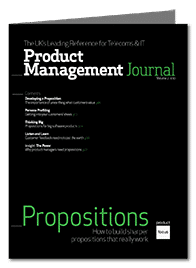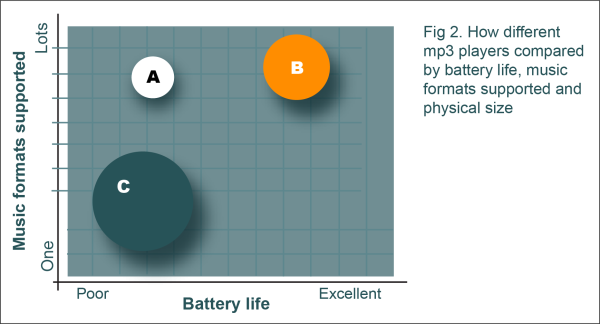Every product is part of a proposition your business presents to its customers even if you haven’t been through the process of analyzing exactly what it is. A proposition should be a clear statement of the benefits a specific group of customers gets from your solution. It should focus on how the benefits address what customers really want and what differentiates you from the competition.
You can read all the articles in our Product Management Journal – Propositions by signing up for free here.
As a product manager, you’ll find propositions extremely useful throughout the product lifecycle. In the early stages, they force you to think about why you are developing a product and why customers will buy it. During development, they help you to paint a vision that the development team can understand and work towards. At launch, they provide high-quality content for marketing to develop brochures and other collateral. And, in-life they provide the key arguments to help your sales channels sell your product.
Step 1: Gain Insight
Proposition development starts with a full understanding of your own product, what target customers value, and what competitors offer. Only then is it possible to develop clearly differentiated, customer-oriented propositions. At this stage, you are trying to build an understanding of the target market, competitors, and the potential offers that you could bring to market.
Target market: Who are the target customers? What will they value? What problems do they have that you might be able to help resolve?
Competition: Which segments are being targeted? What positioning has the competition adopted? What do they promote as their differentiators? What are their real capabilities? Are there alternate solutions, as well as direct competitors?
Potential offers: What are the features, advantages, and benefits of your product? What else could be included in a customer offer? What partnerships do you have, or could have, that might enhance the offer?
When you have limited time and information, it can be difficult to gain sufficient insights to develop worthwhile propositions. However, the reality in most cases is that you’re not starting from a blank sheet, but basing your research on numerous past customer meetings, years of market experience, and feedback from the sales team.
At the end of this stage, you should have developed several draft propositions that could be offered to the same or different target markets. Bear in mind that the same base product can underpin many propositions.
Step 2: Optimize
This next stage often missed, compares the draft propositions against our understanding of what the competition offers. Each of the draft propositions has a set of features intended to appeal to a particular target market – it might be specific functionality, a particular aspect of performance, or a price option.
What we do at this stage is to start building the differentiation story by taking features and mapping ourselves and our competitors on positioning maps. In the case of MP3 players in the late 1990s, manufacturers were focusing their efforts on compatibility, battery life, and size. A product manager in that field might also have considered price, memory size, ease of use, sound recording features, display quality. and so on. He or she will have been looking for features that gave ‘clear water ‘ differentiation compared to their competitors.
In the case of MP3 players (Fig.2), product B has the best battery life and widest range of support for music formats – supporting key market messages about their customers’ ability to play anything, anywhere, for longer. The size of the circle represents the size of the device: the bigger the circle, the smaller the device. Product C supports a different proposition based on its smaller size with no particular strength in either battery life or ability to play different music formats.
The features that give us differentiation are now going to be evaluated through customers’ eyes. We may be differentiated from our competitors but, will our target customers care about the features that distinguish us, or will they say “So what?”
It is salient to reveal at this point that MP3 player C was, in fact, the Apple iPod. Apple’s understanding of what the customers valued meant a completely different proposition map. They recognized better than most what really mattered. Customers didn’t really value small size; it was the thinness of the device that made it easier to carry. They didn’t want lots of features and buttons, but the ease of the click wheel. Support for multiple formats just creates headaches for most customers; the simplicity of quickly copying all your music onto your device from a PC makes it attractive. Apple saw these features as the battleground on which they would compete (Fig.3). Circle size, in this case, represents ease of getting your music on the device (iTunes).
With regard to the other attributes, Apple provided a relatively poor offering compared to many of their competitors: a poorer display, shorter battery life, and incompatibility with many of the music formats that were prevalent. These trade-offs could only be taken because they had an understanding of customer needs and a focus on meeting those that mattered.
While we can’t all perform like Apple, we should always be aware that most customers couldn’t care less about our product or service. They want to know what it can do for them, how it will solve some problem or help them, achieve some career or business objective.
Carrying out this analysis into the importance that target customers place on the different benefits of the whole product offering is certainly not easy. It requires an in-depth understanding of what drives and motivates customers and what they value.
Not all features have the same value to all prospective customers, so this may be the point at which it becomes apparent that you need to segment and target specific groups of customers with different value propositions.
Step 3: Communicate
The final step is to create a document or presentation that describes how the proposition meets the needs of a specific set of target customers.
How do you represent value in a proposition? One approach is to construct a model that quantifies the value to a customer of features based on £££s. Ideally, your model will show how your unique features save or make money for the customer compared to the competition. Of course, it’s often very difficult to develop a believable scenario because of all the assumptions you have to make, so it’s important to test your assumptions with customers to ensure you build a credible model.
Another approach is to compare and present product features against the next best alternative. In most markets, products are pretty similar, so this is a way of teasing out key differences. The trick is to link the feature differences to the 1 or 2 key benefits that you believe are most important to the customer, and support these with as many proof points as possible. The Example Proposition Crib Sheet (click here for a copy) is based on a mythical hosted email service. This crib sheet is a powerful tool to give to your sales channel.
Conclusion
Developing propositions is not rocket science, but it takes dedicated time and resources to do well. However, we believe it’s worth the investment. Having a well-developed proposition puts you in the driving seat within your business by providing a vision of what needs to be developed, what’s important and what’s not.
It also clearly articulates why customers should buy from you and not from the competition, significantly reducing the chances of your product failing in the marketplace.
Read more about Proposition Development.





